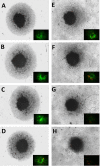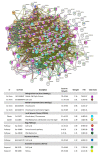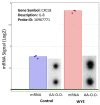Effects of Wild Yam Root (Dioscorea villosa) Extract on the Gene Expression Profile of Triple-negative Breast Cancer Cells
- PMID: 34697066
- PMCID: PMC8569819
- DOI: 10.21873/cgp.20294
Effects of Wild Yam Root (Dioscorea villosa) Extract on the Gene Expression Profile of Triple-negative Breast Cancer Cells
Abstract
Background/aim: Wild yam extract [Dioscorea villosa, (WYE)] is consistently lethal at low IC50s across diverse cancer-lines in vitro. Unlike traditional anti-cancer botanicals, WYE contains detergent saponins which reduce oil-water interfacial tensions causing disintegration of lipid membranes and causing cell lysis, creating an interfering variable. Here, we evaluate WYE at sub-lethal concentrations in MDA-MB-231 triple-negative breast cancer (TNBC) cells.
Materials and methods: Quantification of saponins, membrane potential, lytic death and sub-lethal WYE changes in whole transcriptomic (WT) mRNA, miRNAs and biological parameters were evaluated.
Results: WYE caused 346 differentially expressed genes (DEGs) out of 48,226 transcripts tested; where up-regulated DEGS reflect immune stimulation, TNF signaling, COX2, cytokine release and cholesterol/steroid biosynthesis. Down-regulated DEGs reflect losses in cell division cycle (CDC), cyclins (CCN), cyclin-dependent kinases (CDKs), centromere proteins (CENP), kinesin family members (KIFs) and polo-like kinases (PLKs), which were in alignment with biological studies.
Conclusion: Sub-lethal concentrations of WYE appear to evoke pro-inflammatory, steroid biosynthetic and cytostatic effects in TNBC cells.
Keywords: Dioscorea; Immune stimulation; breast cancer; cell cycle; wild yam.
Copyright© 2021, International Institute of Anticancer Research (Dr. George J. Delinasios), All rights reserved.
Conflict of interest statement
The Authors declare that they have no conflicts of interest.
Figures











Similar articles
-
Final report of the amended safety assessment of Dioscorea Villosa (Wild Yam) root extract.Int J Toxicol. 2004;23 Suppl 2:49-54. doi: 10.1080/10915810490499055. Int J Toxicol. 2004. PMID: 15513824 Review.
-
The anticancer potential of steroidal saponin, dioscin, isolated from wild yam (Dioscorea villosa) root extract in invasive human breast cancer cell line MDA-MB-231 in vitro.Arch Biochem Biophys. 2016 Feb 1;591:98-110. doi: 10.1016/j.abb.2015.12.001. Epub 2015 Dec 10. Arch Biochem Biophys. 2016. PMID: 26682631
-
Lipidated steroid saponins from Dioscorea villosa (wild yam).Fitoterapia. 2013 Dec;91:113-124. doi: 10.1016/j.fitote.2013.07.018. Epub 2013 Aug 19. Fitoterapia. 2013. PMID: 23968665 Free PMC article.
-
Evaluation of wild yam (Dioscorea villosa) root extract as a potential epigenetic agent in breast cancer cells.In Vitro Cell Dev Biol Anim. 2015 Jan;51(1):59-71. doi: 10.1007/s11626-014-9807-5. Epub 2014 Aug 23. In Vitro Cell Dev Biol Anim. 2015. PMID: 25148825
-
Research and Development of Proteins and Peptides with Therapeutic Potential from Yam Tubers.Curr Protein Pept Sci. 2019;20(3):277-284. doi: 10.2174/1389203719666180622094356. Curr Protein Pept Sci. 2019. PMID: 29932033 Review.
Cited by
-
Extraction of Active Compounds from Dioscorea quinqueloba and Their Encapsulation Using Mucin and Chitosan for Application in Cosmetic Formulations.Materials (Basel). 2025 May 8;18(10):2178. doi: 10.3390/ma18102178. Materials (Basel). 2025. PMID: 40428915 Free PMC article.
-
Use of Saponinosomes from Ziziphus spina-christi as Anticancer Drug Carriers.ACS Omega. 2022 Aug 4;7(32):28421-28433. doi: 10.1021/acsomega.2c03109. eCollection 2022 Aug 16. ACS Omega. 2022. PMID: 35990496 Free PMC article.
-
Clinicopathological and Prognostic Significance of Programmed Death Ligand-1 SP142 Expression in 132 Patients With Triple-negative Breast Cancer.In Vivo. 2022 Nov-Dec;36(6):2890-2898. doi: 10.21873/invivo.13030. In Vivo. 2022. PMID: 36309362 Free PMC article.
References
-
- Aumsuwan P, Khan SI, Khan IA, Avula B, Walker LA, Helferich WG, Katzenellenbogen BS, Dasmahapatra AK. Evaluation of wild yam (Dioscorea villosa) root extract as a potential epigenetic agent in breast cancer cells. In Vitro Cell Dev Biol Anim. 2015;51(1):59–71. doi: 10.1007/s11626-014-9807-5. - DOI - PubMed
-
- Chiang CT, Way TD, Tsai SJ, Lin JK. Diosgenin, a naturally occurring steroid, suppresses fatty acid synthase expression in HER2-overexpressing breast cancer cells through modulating Akt, mTOR and JNK phosphorylation. FEBS Lett. 2007;581(30):5735–5742. doi: 10.1016/j.febslet.2007.11.021. - DOI - PubMed
MeSH terms
Substances
Grants and funding
LinkOut - more resources
Full Text Sources
Molecular Biology Databases
Research Materials
Miscellaneous
